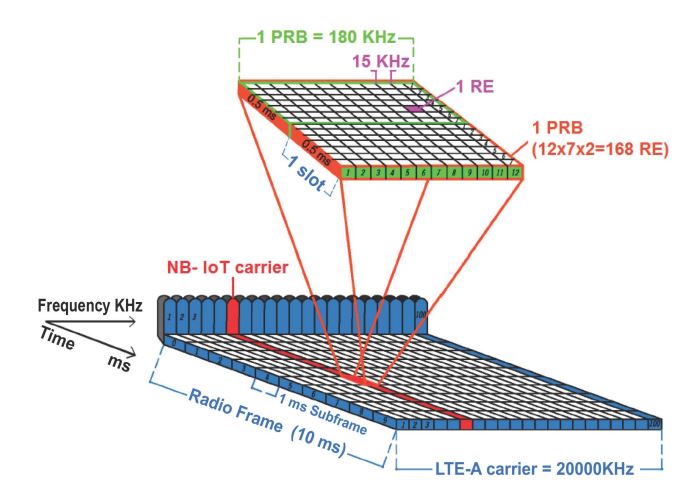LTE is a widely used cellular technology that provides high-speed data services to mobile devices. One of the key components of LTE is the physical resource block (PRB). In this article, we will explore the basics of PRBs, their characteristics, and their importance in the LTE network.

Fig 1 from articacl: CTMC modeling for M2M/H2H coexistence in a NB-IoT Adaptive eNodeB
What is a Physical Resource Block (PRB)?
A PRB is a basic unit of frequency and time resources in LTE networks. It is a fixed-size channel that can be allocated to a user to transmit or receive data. Each PRB has a bandwidth of 180 kHz and a duration of 1 millisecond. The number of PRBs allocated to a user depends on the required data rate and available network resources.
Terminology
When discussing an LTE Frame, it’s important to understand some of the terms used to describe it. The unit of time is broken into six parts: frame, half-frame, subframe, slot, symbol and Ts which is the smallest unit of time.
Time Unit Value
Frame 10 ms
Half-frame 5 ms
Subframe 1 ms
Slot 0.5 ms
Symbol (0.5 ms) / 7 for normal CP
(0.5 ms) / 6 for extended CP
Ts 1/(15000 * 2048) sec » 32.6 ns
Below is an illustration of an FDD frame.
Frequency units can be measured by the number of subcarriers or resource blocks. For example, a 5MHz downlink signal may be described as 25 resource blocks or 301 subcarriers wide (not including the DC subcarrier in a resource block).
An LTE frame is composed of Resource Elements (REs), which are the smallest parts, 1 subcarrier by 1 symbol in size. These REs contain a single complex value for each physical channel or signal, representing relevant data.
Bandwidths
According to the standard, the available bandwidths are 1.4, 3, 5, 10, 15 and 20 MHz. The below table illustrates how many subcarriers & resource blocks each of these specifications contain for both uplink & downlink.
Bandwidth Resource Blocks Subcarriers (downlink) Subcarriers (uplink)
1.4 MHz 6 73 72
3 MHz 15 181 180
805 MHz 25 301 300
10 MHz 50 601 600
15 MHz 75 901 900
20 MHz 100 1201 1200
The Importance of PRBs
The allocation of PRBs is a critical factor in determining the data transmission rate and the quality of service for the user. In LTE, the maximum number of PRBs that can be allocated to a user is 100, which corresponds to a total bandwidth of 20 MHz. This means that a user can transmit or receive up to a certain amount of data within a given time frame, depending on how many PRBs are allocated to them.
PRBs are also important for the efficient use of network resources. By dynamically allocating PRBs to users, the network can optimize the utilization of its resources and maximize the number of users that can be served simultaneously.
PRB Allocation
PRBs are allocated based on the quality of service (QoS) requirements and available network resources. The allocation process is controlled by the eNodeB, which is the base station in the LTE network. The eNodeB uses scheduling algorithms to determine the allocation of PRBs to users based on their QoS requirements, traffic demand, and network conditions. The allocation of PRBs is a critical factor in determining the data transmission rate and the quality of service for the user. The number of PRBs allocated to a user depends on the required data rate and available network resources. In LTE, the maximum number of PRBs that can be allocated to a user is 100, which corresponds to a total bandwidth of 20 MHz.
PRBs are also important for the efficient use of network resources. By dynamically allocating PRBs to users based on QoS requirements and network conditions, the network can optimize the utilization of its resources and serve a large number of users.
To calculate the amount of PRBs needed to transmit data at a specific data rate, the following formula can be used:
PRBs = (Data Rate × Transmission Time) / (Number of Bits per PRB × PRB Bandwidth)
For example, if we want to transmit data at a rate of 10 Mbps for 1 second using LTE, we can calculate the number of PRBs required as follows:
PRBs = (10 × 10^6 × 1) / (12 × 10^3 × 180 × 10^3) = 4.63
This means that we would need to allocate at least 5 PRBs to achieve a data rate of 10 Mbps for 1 second.
Masuere and Monitoring PRB is Vital
By monitoring and measuring the utilization rate of the element during peak hours, network operators can identify areas where the network may be experiencing congestion or other capacity-related issues. In order to timely detect and notify any anomalies that may occur in the network, TTG’s PM solution NORTH-I constantly monitors PRBs and other important metrics and KPIs and automatically reviews them for you. This can help them optimize network resources, adjust network configurations, and improve the overall quality of the user experience during periods of high usage.Let’s reinforce what we said with an example.
Let’s say that a particular network element in a mobile network has a theoretical traffic capacity of 100 Mbps, based on its current PRB capacity. However, historical traffic data shows that on average, the element only carries 80 Mbps of traffic during peak hours.
To calculate when the element will fill its capacity, we can first determine the utilization rate of the element during peak hours, which is:
Utilization rate = (80 Mbps / 100 Mbps) x 100% = 80%
Next, we can use this utilization rate to estimate how long it will take for the element to reach full capacity, assuming traffic levels remain consistent:
Time to full capacity = (100% – 80%) x (24 hours/day) = 4.8 hours
This calculation suggests that during peak hours, the network element will reach its full capacity within 4.8 hours if traffic levels remain consistent. This information can help network operators plan for capacity upgrades or other measures to optimize network performance during high-traffic periods.
Conclusion
In summary, PRBs are a fundamental building block of LTE networks, providing a fixed-size channel that can be allocated to a user for data transmission. The number of PRBs allocated to a user determines the data transmission rate and the quality of service. By dynamically allocating PRBs based on QoS requirements and network conditions, the network can maximize its resource utilization and efficiently serve a large number of users.



